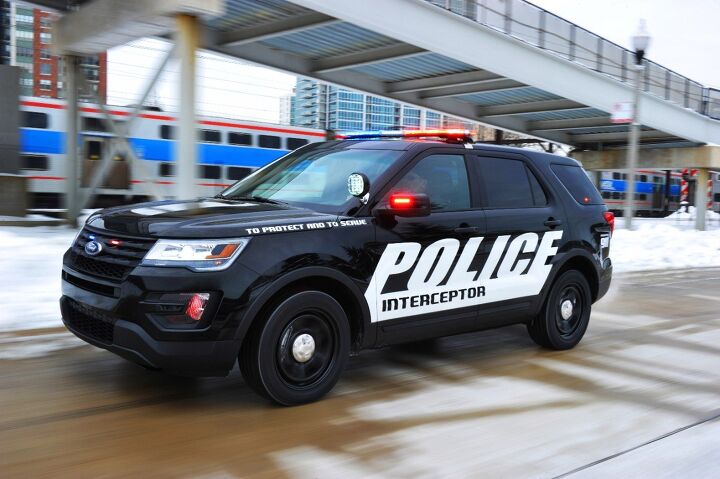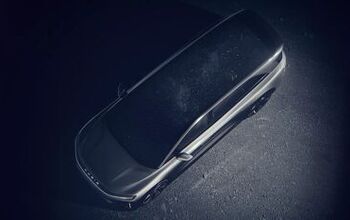SUVs Likely to Become Dominant Police Vehicle, 'Bigger' Cops Rejoice

North America’s romantic entanglement with the sport utility vehicle is not limited to retail consumers, as police fleets in the United States and Canada have been getting in on the action for a while now. Valuing durability and flexibility above all else, law enforcement’s gradual shift toward SUVs seems to have been inevitable.
Ford said that sales of its Explorer-based Interceptor Utility surpassed its Taurus-based Interceptor Sedan in 2014, claiming that the SUV had “officially” become North America’s most popular police vehicle. While that might not be entirely accurate until current fleets retire the horde of large sedans that proved so popular in the past, the utility trend is growing and departments have plenty of praise for them — especially departments rife with oversized officers.
“We’re all dealing with the same issue, and that is the vehicles are getting smaller, yet there’s still demand for more gadgets and equipment put into those cars,” Julie Furlotte, the Royal Canadian Mounted Police’s national mobile assets manager, told Automotive News. “It’s always a bit of a tradeoff and a challenge to make it all fit.”
When Ford retired the Crown Victoria P7B Interceptor, its replacement was praised for superior performance and versatility but universally loathed for its less spacious interior. This week, South Carolina’s Greenville PD gave those very reasons for why it decided to swap out its entire fleet to sport utility vehicles.
“We’re trying to make sure we have a fleet that serves many purposes. Having all-wheel-drive vehicles will help during bad weather, we’ll be able to respond to calls more quickly,” Officer Gilberto Franco told WYFF 4. “For officers who are very tall or just bigger in size, they were having a difficult time trying to get in and out of the vehicle.”
While it’s easy to scoff at chubby cops and make jokes about staying away from the donut shop, interior comfort and space are incredibly important when considering a vehicle that doubles as your office — even more so when you are big-boned.
“The larger the guy, the harder it is to get into a smaller car,” said Sgt. Michael McCarthy of the Michigan State Police’s precision-driving team. “The SUVs are up higher, they’re easier to get in and out of. I love driving the sedans as long as I can stay in them but if I have to get in and out of them all day I much prefer a taller vehicle.”
Every year, the Michigan State Police tests all available pursuit vehicles, and those evaluations become the deciding factor for many departments’ purchases. McCarthy says that, in recent years, the performance differences between police sedans and SUV has become much less noticeable.
“LAPD are buying a larger percentage of SUVs than they are of the sedans,” McCarthy said. “They are very capable. They have a fairly short turning radius. They’re deceptively fast.”
Ease of entry and egress for husky or hulking officers isn’t the sole benefit, however. Durability plays a massive factor for fleet vehicles in general and is another reason the Crown Victoria was the darling of so many police departments and cab companies.
Fred Dixon, GM Canada’s manager of fleet marketing and sales, told Automotive News that the body-on-frame design of the Chevrolet Tahoe has kept repair costs down.
“I’m hearing from my customers anyway that when they look at the sedan versus the SUVs, the SUVs are a little bit more expensive (but) they actually get better durability out of them,” Dixon explained.
Meanwhile, Ford’s Interceptor Utility shares many parts with the Interceptor Sedan, reducing maintenance expenses and making it easier to rationalize adding them to a fleet already brimming with spare components. The Blue Oval also had the foresight to design the SUV as a pursuit-rated vehicle — bullet-resistant armor and all.
Those factors helped Ford quickly retake a dominant share — over 61 percent — of the police fleet market in 2015.
Introduced in 2012, the Police Interceptor Utility only needed a couple of years to become America’s best-selling police vehicle. By 2014, Ford starting selling roughly 25 percent more Interceptor SUVs than it does the already popular Interceptor sedan.
Cops want utility vehicles, and all available data points to a future where —outside of major urban centers — SUVs are the most common squad car on the road.
[Image: Ford Motor Company]

A staunch consumer advocate tracking industry trends and regulation. Before joining TTAC, Matt spent a decade working for marketing and research firms based in NYC. Clients included several of the world’s largest automakers, global tire brands, and aftermarket part suppliers. Dissatisfied with the corporate world and resentful of having to wear suits everyday, he pivoted to writing about cars. Since then, that man has become an ardent supporter of the right-to-repair movement, been interviewed on the auto industry by national radio broadcasts, driven more rental cars than anyone ever should, participated in amateur rallying events, and received the requisite minimum training as sanctioned by the SCCA. Handy with a wrench, Matt grew up surrounded by Detroit auto workers and managed to get a pizza delivery job before he was legally eligible. He later found himself driving box trucks through Manhattan, guaranteeing future sympathy for actual truckers. He continues to conduct research pertaining to the automotive sector as an independent contractor and has since moved back to his native Michigan, closer to where the cars are born. A contrarian, Matt claims to prefer understeer — stating that front and all-wheel drive vehicles cater best to his driving style.
More by Matt Posky
Latest Car Reviews
Read moreLatest Product Reviews
Read moreRecent Comments
- Redapple2 Good luck to them. They used to make great cars. 510. 240Z, Sentra SE-R. Maxima. Frontier.
- Joe65688619 Under Ghosn they went through the same short-term bottom-line thinking that GM did in the 80s/90s, and they have not recovered say, to their heyday in the 50s and 60s in terms of market share and innovation. Poor design decisions (a CVT in their front-wheel drive "4-Door Sports Car", model overlap in a poorly performing segment (they never needed the Altima AND the Maxima...what they needed was one vehicle with different drivetrain, including hybrid, to compete with the Accord/Camry, and decontenting their vehicles: My 2012 QX56 (I know, not a Nissan, but the same holds for the Armada) had power rear windows in the cargo area that could vent, a glass hatch on the back door that could be opened separate from the whole liftgate (in such a tall vehicle, kinda essential if you have it in a garage and want to load the trunk without having to open the garage door to make room for the lift gate), a nice driver's side folding armrest, and a few other quality-of-life details absent from my 2018 QX80. In a competitive market this attention to detai is can be the differentiator that sell cars. Now they are caught in the middle of the market, competing more with Hyundai and Kia and selling discounted vehicles near the same price points, but losing money on them. They invested also invested a lot in niche platforms. The Leaf was one of the first full EVs, but never really evolved. They misjudged the market - luxury EVs are selling, small budget models not so much. Variable compression engines offering little in terms of real-world power or tech, let a lot of complexity that is leading to higher failure rates. Aside from the Z and GT-R (low volume models), not much forced induction (whether your a fan or not, look at what Honda did with the CR-V and Acura RDX - same chassis, slap a turbo on it, make it nicer inside, and now you can sell it as a semi-premium brand with higher markup). That said, I do believe they retain the technical and engineering capability to do far better. About time management realized they need to make smarter investments and understand their markets better.
- Kwik_Shift_Pro4X Off-road fluff on vehicles that should not be off road needs to die.
- Kwik_Shift_Pro4X Saw this posted on social media; “Just bought a 2023 Tundra with the 14" screen. Let my son borrow it for the afternoon, he connected his phone to listen to his iTunes.The next day my insurance company raised my rates and added my son to my policy. The email said that a private company showed that my son drove the vehicle. He already had his own vehicle that he was insuring.My insurance company demanded he give all his insurance info and some private info for proof. He declined for privacy reasons and my insurance cancelled my policy.These new vehicles with their tech are on condition that we give up our privacy to enter their world. It's not worth it people.”
- TheEndlessEnigma Poor planning here, dropping a Vinfast dealer in Pensacola FL is just not going to work. I love Pensacola and that part of the Gulf Coast, but that area is by no means an EV adoption demographic.


































Comments
Join the conversation
So what they really needed was a minivan. Ideally the rental-grade Sienna with the 2.7L I4. Jack called this one years ago. Cops liked the CV because it had a long hood. They liked the Charger because it had a crosshair on the grille. They like the Explorer because it rides high and has an imposing visage in interceptor trim. I don't doubt it's a pain to get into a modern sedan with a vest and a belt, but if the answer to that is a Tahoe or an Explorer, then this is first and foremost about the paramilitary theater of modern policing.
The most common police vehicle in the Dallas suburbs is the Chevrolet Tahoe. Black and white, slightly lowered, steel wheels, and 2WD. Not many Crown Vics were replaced by Tauruses.